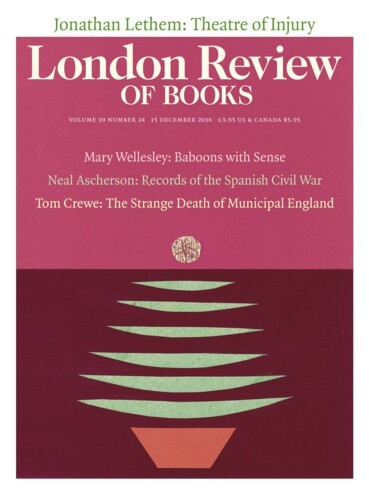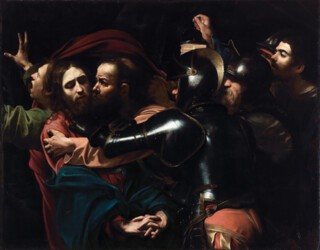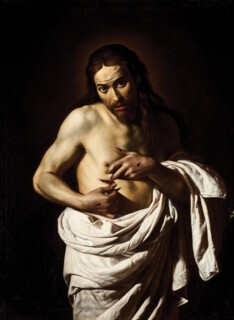A burnished pauldron – the cupped steel armour protecting a soldier’s shoulder – gleams at the centre of Caravaggio’s The Taking of Christ, which in turn forms the centrepiece to the National Gallery’s exhibition Beyond Caravaggio (until 15 January). The painter keeps pace with the armourer. He flaunts an immaculate curving surface on which his own brushstrokes, like the hammer blows that preceded them, have cancelled themselves out, the better to celebrate the metal – both its hard inward darkness and the way it flashes back light. This is beauty, Caravaggio-style. An object is illuminated and scrutinised until its textures sing out. Comparable pleasures are on offer when Caravaggio paints a glass vase in the National Gallery’s Boy Bitten by a Lizard or a basket of fruit in Supper at Emmaus (the latter, painted in 1601, has been hung next to The Taking of Christ from 1602.) This, after all, was the young Lombard’s calling card when Roman patrons led by Cardinal del Monte began commissioning Caravaggio in the mid-1590s: an unprecedented technical prowess, allowing him to deliver descriptions of physicality so acute and luscious that they left words behind.
Poets such as Giovan Battista Marino soon began to twist admiring conceits around this startling immediacy. More verbal wrapping has swathed Caravaggio since he returned, in the 1950s, to the art-historical spotlight after three centuries in the wings. But commentators are all on the back foot. We might argue that having trained in the north, Caravaggio learned artistic manners brasher than those with which his central Italian contemporaries felt comfortable, and that Counter-Reformation ideologues approved of this trenchant approach. It is hard, however, to find textual correlatives for the repertory of effects he launched with Boy Peeling Fruit, which, dating from around his arrival in Rome aged 20 in 1592, seems to be his earliest known work. Del Monte was one of the city’s foremost sophisticates, with interests ranging from monodic music to Galileo’s science, but Caravaggio, who lodged in his palace, appears anti-intellectual if you set him in the context of the city’s art politics. To one side, the highbrow Mannerist Federico Zuccaro was setting up the Accademia di San Luca; to another, Bologna’s Annibale Carracci was reanimating the legacy of Raphael with ambitious frescoes. If Caravaggio had a tactic, it was to outflank the former’s theories of disegno and the very practice of drawing on which Annibale based his art, by the sheer grip of his brush on the canvases in his studio.
No preparatory sketches survive to refute Caravaggio’s claim that he didn’t use them. His novelty subjects included card-sharps and fortune-tellers he might have met at the bar down the street, and when, after seven years in Rome, he landed a commission for two big paintings for the Contarelli Chapel, he completed his sidestep by opting for models – and costumes – from the same milieu. What, if any, principle was at stake? The only time that Caravaggio was pushed to define what made painters good at their job was when he was in court for slander in 1603. His response couldn’t have been more terse: ‘to imitate natural things well’.
The self-cancelling brushstrokes ‘belonged not to him, but to nature’, he is also reported to have said. Minimal directives like these don’t close the discussion, however – they provoke it. What, then, is nature? Does it extend to the textures of objects? Giovanni Pietro Bellori, whose 1672 Lives of the Modern Painters provides the first mention of The Taking of Christ, praised Caravaggio’s hold on nature, noting the way his soft umber underpainting ‘imitated the rusty armour’. But the steel is also polished, so that the tones fly apart, prompting the painter to reach for dense ivory black and lead white. It gets hard to see the object steadily. This effect presages the ‘dark style’ met later in the exhibition in Caravaggio’s St John the Baptist in the Wilderness (1603) and his Salome of c.1609, a forsaking of fine description for brute urgency that met with Bellori’s censure.
For a follower, like Bellori, of the Italian tradition based on figure drawing and epitomised by Raphael, the metal cladding would have constituted a modern adjunct to the natural form – the body – underneath, of which only an inexpressive nose pokes out. But here that logic feels reversed. Surrounded not by whole bodies but by disconnected passages of flesh, the armour abstracts its bearer, redefining him as a machine part. The picture’s flash and soulless centre imagines the gospel story of tragic sacrifice as a flare-lit car crash, a clatter of hardware. There are agonised jolts – Judas molests, Jesus squirms, John screams – but these reactions don’t seem governed by human agency. Is this what ‘nature’ amounts to, this dark drive to which the picture’s protagonists – and its painter, shown struggling for a glimpse – have been bound?
Beyond Caravaggio, which invites us to consider European painting in the wake of the artist’s death, at 39, in 1610, demonstrates how hard it can be to get beyond Caravaggio. Most of all, beyond The Taking of Christ, which was only rediscovered in 1990 in a Jesuit seminary in Dublin. Around it the National Gallery has assembled a show that is oddly persuasive, considering that its loan policy amounts to a form of Brexit. What we encounter of Caravaggio and the caravaggeschi is whatever happens to be available in British and Irish collections, plus four items from the US. Letizia Treves, the curator, in arranging the works thematically, has managed to achieve a lively interrelation of canvases and shows that it’s possible to represent several facets of the show’s protagonist. What you can’t show so well, however, without loans from the Continent, are the personalities of the company that surrounds him here.
It’s not hard to relate the Caravaggio of popular notoriety – the street-strutting paranoid who seems to come from the north with blood already on his hands – to the picture from Dublin. Look closer, and it opens onto another persona, the clever, discriminating magpie befriended by del Monte, who adapted a Dürer print, The Betrayal of Christ, for his portrayal of Jesus, Judas and the soldier. Holding both these personalities in check in the six Caravaggios on display is a painter in his element, an extraordinarily cool-headed studio professional. With one hand he’s directing the model to enact the Dürer pose: with the other he’s quickly recording the patterns of light across this body part or that on an umbered canvas. David Hockney’s now familiar guess that lenses covertly facilitated Caravaggio’s cinematic effects came with a salute to his ‘terrific talent’. My guess is that we should cut out the middleman, and that the only apparatus involved was Caravaggio’s own deadpan, dead clear vision.
Yet it’s true that Caravaggio was proudly secretive about his rapport with ‘nature’, whatever he believed that to consist in. He threatened to beat up Guido Reni for trying to steal his tricks and would have hated having to share wall space with Reni’s Lot and His Daughters – chiaroscuro half-length figures, slickly Raphaelised. Caravaggio’s boyfriend Cecco – the nearest thing he had to an heir – read his master’s legacy as one of disdainful virtuosity, to judge from two paintings in which sneery hucksters overlook imperious still lives. If Caravaggio got along with Orazio Gentileschi, it was because Gentileschi was surefooted enough to bow to the younger man’s new style without falling on his face; his two figure dramas here – each, unlike Caravaggio, alert to sky and atmosphere – indicate an original vision that deserves a show of its own. If Orazio, Caravaggio and others slandered Baglione as an incompetent imitator, the Baglione on show, an Ecstasy of St Francis from 1601, suggests they were correct.
The pattern here compares to that of la bande à Picasso, circa 1910. We’re in the art metropolis and there’s a new man in town, who’s none too keen to explain himself. Dismiss what he’s up to if you can (‘too natural’, Annibale protested; Zuccaro claimed that Caravaggio had lifted his act from Giorgione), but if you can’t, how, as a self-respecting painter, are you to go forward? In this case, the man himself abruptly disappeared – he was on the run after killing a street-cruiser in 1606 – but in Caravaggist Rome, as in Cubist Paris, it was the new way of looking that posed the real challenge, a challenge plenty of gifted painters were willing to take up. It is these people you only manage to glimpse when you settle for a selection from the collections in the British Isles. Bartolomeo Manfredi, painting Caravaggesque bar scenes in the 1610s, and Giovanni Serodine, painting from the gospels in the 1620s, seem to want to thaw their forebear’s descriptive froideur with some Venetian painterliness, but it’s hard to get their measure. To see the disaffected vision of Valentin de Boulogne, a major figure in Rome before a chill carried him off in 1632 (fellow boozers had dunked him in a fountain), you would need to fly to the current exhibition at the Met in New York (until 16 January).
What does emerge from the large dark Roman canvases is attitude. The world today, they seem to proclaim, revolves around a bar table. Songs, drinks and dice: what else does life come down to? But something is rotten. There’s a scowler in the middle, a prodigal son; is he simply hungover, or is he a Hamlet with ‘bad dreams’? Caravaggio’s legacy reads quite differently when adapted, say, by Orazio’s daughter Artemisia for her dignified feminism, or by the rigorous Jusepe de Ribera, but these painters’ canvases, and still more those of Georges de La Tour, who inhabited a separate artistic planet, really require further shows. What best counterpoints the Roman glumness is the geniality with which Dutchmen such as Gerrit van Honthorst responded to Caravaggio. Christ before the High Priest (1617) may be a familiar fixture of the National Gallery but in this company its candlelit Jesus shines out as a beacon of intelligent non-violent resistance. The relation of this Dutch positivity to developments in Rome may be partly a trick of the light. (There’s a Marriage at Cana in the Rijksmuseum by Jan Vermeyen that seems to use much of the Caravaggio toolkit, only it was painted in 1530.) But if those developments constituted some sort of ‘revolution’ (the National Gallery catalogue makes use of the term), it was one that had been reversed on its home ground by the time Valentin was dropped in the fountain. Poussin directed his colleagues in Rome towards a pictorial approach compatible with Raphael and Annibale, reportedly claiming that Caravaggio had come ‘to destroy painting’; his friend Bellori, more measuredly, inserted the ‘naturalist’ revolt, with its various excesses, into a kind of Whig art history. No ripostes survive: the caravaggeschi trusted to bar brawls rather than academy debate.
In fact, in front of The Taking of Christ or Salome, painted not long before Caravaggio’s death, you can see how Poussin’s charge might stick. Caravaggio destroys painting in the sense that he turns his back on the world, on the spacious totality of phenomena saluted whenever his great Italian predecessors, from Giotto to Raphael and Titian, painted narrative. ‘Nature’ might be a label for that broad vision, in which whole figures represented the norm. But in Caravaggio’s trajectory, nature gets drastically reduced. At first he depicts no more than what you can immediately see, then that goes too. Where it ends up, words don’t quite adequately express. Why expect them to? He leaves writers to cast about for literary or psychological correlatives: there were so many ways a European mind might range in the age of Hamlet, and this was surely a mind in which guilt clanged and resounded. But start to see behind the visible world, and you look beyond the aim of painting: to imitate that nature. You expose the fragility of the faith sustaining that ambition.
There’s only one Roman successor here who seems to look Caravaggio in the eye, in all his driven unhappy yearning. Not much is known about Giovanni Antonio Galli, ‘Lo Spadarino’, though if he did paint Perth Museum’s astonishing Christ Displaying His Wounds (c.1625), I can’t believe he also painted the listless Incredulity of St Thomas with which he’s also credited. The Perth painting takes the Caravaggesque method and returns it to the prenatal state of Italian art history, the condition of iconhood. ‘Accept’ and ‘believe’ are the commands from this canvas with the painted rip at its centre. ‘Doubt no longer.’ You might say that this is exactly what the ideologues of the Counter-Reformation would have wished for. But their endpoint for painting makes for hard looking. It pulls you towards a wound’s red lips. They pull you into the dark.
Send Letters To:
The Editor
London Review of Books,
28 Little Russell Street
London, WC1A 2HN
letters@lrb.co.uk
Please include name, address, and a telephone number.



